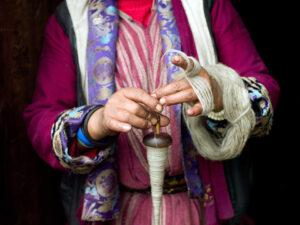Wool from Highland
Sheep rearing has long been an integral part of Bhutan’s highland culture, providing wool for essential products like blankets and clothing. However, the practice is in decline due to challenges such as better alternative income sources, predation by wild animals, loss of pastureland, and the availability of imported goods.
The primary sheep species in Bhutan is the Bhutanese Highland Sheep, found in regions like Phobjikha, Merak, and Sakteng. Sheep played a vital role in sustainable farming by enriching soil with manure and were historically a key source of warmth and cultural pride through handwoven wool products.

Bhutanese sheep wool is carefully processed by hand, often by elderly women sitting by the hearth, where each fiber is meticulously handspun and woven into the warm, cherished blankets known as tsuktsue. These blankets hold such value that in ancient times, they were often divided among siblings as part of a property share, or passed down to children as a treasured inheritance, symbolizing warmth, heritage, and familial bonds.